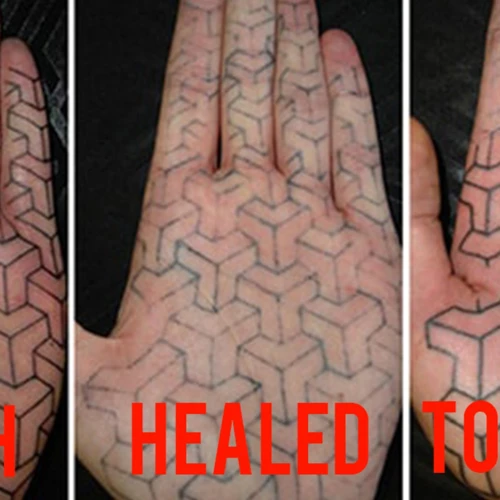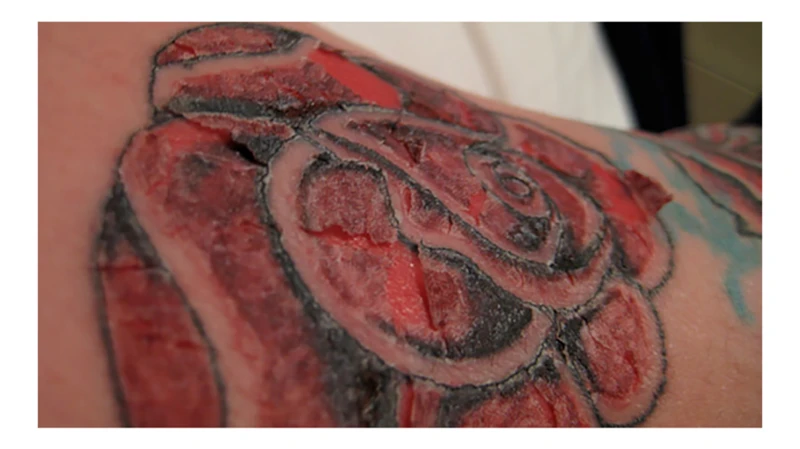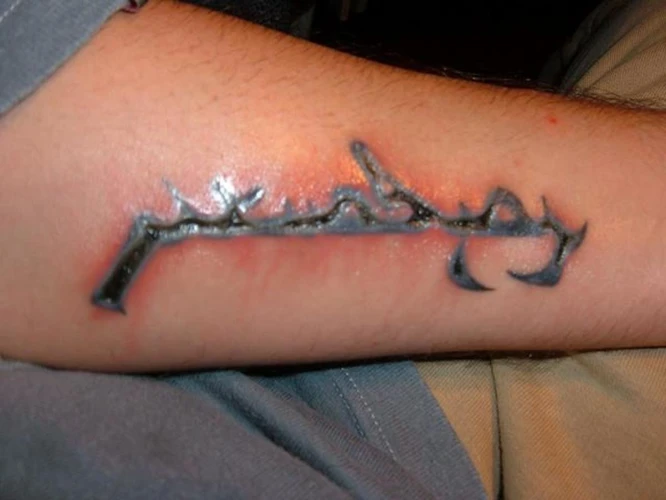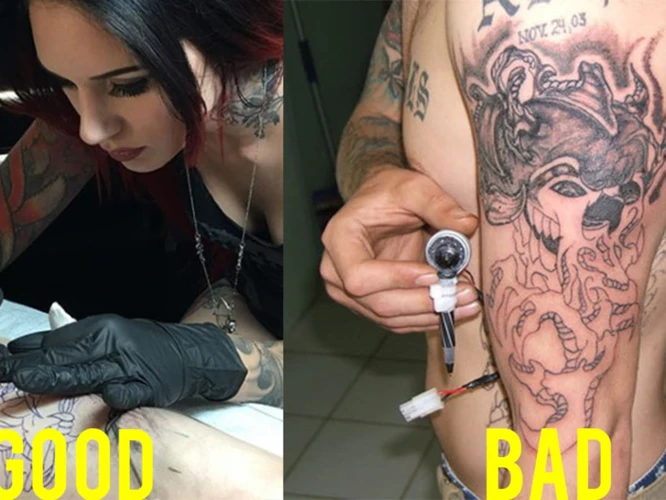Are you concerned that the tattoo ink you are using is bad or expired? If so, you have come to the right place. In this definitive guide, we will provide you with all the information you need to know about how to tell if tattoo ink is bad. We will discuss the signs to look out for, the testing process and how to ensure that the ink you are using is safe for your client’s skin. By the end of this guide, you will be fully informed and equipped to make a judgement as to whether the ink you are using is bad or not.
Contents
What Bad Tattoo Ink Looks Like

The quality of a tattoo is largely dependent on the quality of the ink used. Low-grade ink can cause a tattoo to look dull and faded, while high-grade ink will create a vibrant and long-lasting tattoo. Here are some signs that the ink used in a tattoo may not be of high quality:
- Color Fading: Bad tattoo ink may fade quickly, making the tattoo look dull and washed out.
- Inconsistent Color: Poor quality ink may not be consistent throughout the tattoo, resulting in spots or patches of discoloration.
- Splotchy Results: A tattoo done with bad ink may look splotchy or uneven, with some parts of the tattoo appearing to be darker or lighter than others.
- Infection Risk: Low-grade ink can increase the risk of infection, as it may contain contaminants that can cause irritation and inflammation.
- Allergic Reactions: Bad ink can often cause allergic reactions, resulting in redness, swelling, and itching.
Knowing how to tell if tattoo ink is bad is essential for ensuring a safe and successful tattoo experience. If you notice any of the above signs, it’s important to speak to your tattoo artist to determine if the ink used is of high quality.
How to Test Tattoo Ink

Visual Inspection
The first step to determine whether your tattoo ink is good or bad is to look for any signs of discoloration or separation. If the ink appears cloudy or is not uniform in color, then it may be contaminated or expired. You should also check for any clumps or lumps in the ink, as this could indicate that the ink has gone bad.
If you notice any of these signs, then it’s best to discard the ink and purchase a new batch.
Chemical Testing
Another way to test if your tattoo ink is good is to perform a chemical test. To do this, you will need to mix a small amount of the ink with distilled water. If the mixture is still cloudy or has chunks in it after a few minutes, then it is likely that the ink is bad. Additionally, if the ink has a strong smell or changes color when mixed, then it is likely that the ink is expired or contaminated. In this case, it is best to discard the ink and purchase a new batch.
Overall, How to tell if tattoo ink is good is an important step to ensure your tattoos remain vibrant and safe. With the right tests and visual inspections, you can ensure that your ink is of the highest quality.
Common Contaminants in Tattoo Ink

Tattoo ink is a complex mixture of pigments, solvents, and other ingredients that are used to create permanent images on the skin. However, tattoo ink can be subject to contamination, which can lead to adverse reactions or health risks. To ensure the safety of your tattoo, it is important to know what contaminants could be present in the tattoo ink.
Heavy Metals – Heavy metals such as lead, cadmium, and mercury can be found in some tattoo inks, and can be toxic if absorbed into the body. Many tattoo inks contain trace amounts of heavy metals, which are generally considered safe. However, if the ink has been contaminated, it could contain higher levels of heavy metals that can be dangerous.
Bacterial Contamination – Bacterial contamination can occur when the tattoo ink is not properly sterilized or stored. Bacterial contaminants can cause infections and other skin reactions, such as rashes and swelling.
Chemical Contamination – Chemical contaminants can be found in some inks, including solvents and preservatives. These chemicals can cause skin reactions, such as burning and itching.
Mold and Mildew – Mold and mildew can form in tattoo ink that has been improperly stored or exposed to moisture. These contaminants can cause rashes and other skin reactions.
Fungal Contamination – Fungal contamination can occur when the tattoo ink is not stored properly or exposed to moisture. Fungal contaminants can cause skin infections, as well as rashes and itching.
Viral Contamination – Viral contaminants can be found in some contaminated tattoo inks, and can cause serious infections.
Allergens – Some tattoo inks contain allergens that can cause an allergic reaction. Common allergens include fragrances, dyes, and preservatives.
By knowing the common contaminants that can be found in tattoo ink, you can take steps to ensure that your tattoo is safe and free from any contaminants. It is important to always use a reputable tattoo artist and to inspect the ink before use.
How to Store and Dispose of Tattoo Ink

Tattoo Ink Storage
- Tattoo ink should be stored in an airtight container in a cool and dry place away from direct sunlight.
- For best results, the ink should be stored in a refrigerator.
- The ink should be used within six months of purchase.
- After opening the bottle, the tattoo ink must be used within one or two weeks.
Tattoo Ink Disposal
- Do not pour tattoo ink down the drain.
- Do not put tattoo ink in the garbage.
- Tattoo ink should be disposed of in accordance with your local hazardous waste regulations.
- Contact your local health department for information on how to dispose of tattoo ink properly.
The Dangers of Using Bad Tattoo Ink

Tattoo ink can be a dangerous thing if it is not of good quality. Bad quality ink can cause a range of health issues, including infections, allergic reactions, and scarring. It is important to know what to look out for to make sure the ink you are using is safe.
Infections
Using bad quality tattoo ink can increase the chances of developing a skin infection. Tattoo ink that has not been properly sterilized can contain bacteria and other contaminants which can cause infection. Even if the ink itself does not contain any contaminants, the needle used for the tattoo could be contaminated, leading to infection.
Allergic Reactions
Bad quality tattoo ink can also cause allergic reactions. If the ink contains ingredients which are not safe for the skin, such as heavy metals, it can lead to itching and swelling. If the reaction is severe, it can even cause permanent scarring.
Scarring
Tattoo ink which is of poor quality can cause scarring. The ink itself can be too thick, or it may contain ingredients which are not safe for the skin, leading to scarring. In some cases, the ink may not settle properly into the skin, leading to an uneven appearance which can also cause scarring.
It is important to make sure that the tattoo ink you use is of good quality. Make sure it has been properly sterilized and is free from dangerous contaminants. It is also important to make sure that the needle used for the tattoo is sterile, as this can also lead to infection and scarring.
Tips for Choosing Quality Tattoo Ink

- Check the ingredients: Quality tattoo ink should contain natural ingredients such as vegetable glycerin, witch hazel, and purified water. Avoid any inks containing heavy metals like mercury or lead, as these can be toxic.
- Look for colorfastness: Quality tattoo ink will not fade over time, so look for pigments that are designed to be colorfast. Most quality inks will feature a lightfastness rating.
- Check for consistency: Quality tattoo ink should be consistent in color and texture. If the ink is too thick or too thin, it can cause uneven lines and patchy spots in the tattoo.
- Read reviews: Reading reviews of the ink you’re considering can help you gain insight into how well it performs and the quality of the pigment. It’s also a great way to get recommendations from experienced tattoo artists.
- Shop around: Don’t be afraid to shop around for the best deals on quality tattoo ink. Many online suppliers offer great discounts and free shipping, so you can get the ink you need at a great price.
How to Avoid Bad Tattoo Ink
- Check the tattoo artist’s credentials. Make sure that the artist is qualified and has experience in using the right type of ink for your skin type. Ask questions about the artist’s experience and how long they have been practicing.
- Choose a reputable tattoo shop. Research the shop you’re planning to get a tattoo at. Look up reviews online and make sure the shop is clean and safe. Talk to the tattoo artist and ask about their experience and the shop’s safety protocols.
- Inspect the tattoo ink. Ask to see the ink before it is used. Check that the bottle is sealed and make sure the color is consistent with what you expected. If there is any discoloration or off-smelling odor, don’t use it.
- Know the ingredients. Ask the artist what type of ink they are using and what the ingredients are. Many inks contain chemicals that are not safe for skin, so make sure the ink is safe for your skin type.
- Look for FDA approval. Ask the artist if the ink has been approved by the Food and Drug Administration (FDA). This will ensure that the ink is safe and of good quality.
- Check the expiration date. Make sure the ink is not expired. Expired ink can cause skin irritation and an uneven tattoo.
Frequently Asked Questions
What are some signs that my tattoo ink may be bad?
Color Fading Quickly: Bad ink may not hold the color for very long, causing the tattoo to fade quickly.
Infection: Tattoo ink that is old or contaminated can lead to infection. Look out for redness, inflammation, and discharge near the tattoo.
Allergic Reactions: Metals and other contaminants in bad ink can cause an allergic reaction. This can manifest as rashes, itching, or other skin irritation.
Strange Smell: If your ink has a strange odor, it may be a sign that it has gone bad. Discard it immediately.
Are There Any Precautions I Should Take When Using Tattoo Ink?
When using tattoo ink, it is important to ensure that the ink is stored in a cool, dry place and only used when necessary. Furthermore, thoroughly inspect the ink before use and discard any ink that appears cloudy, discolored, or has visible particles. Additionally, it is important to regularly clean and sterilize any equipment used to apply the ink. Lastly, make sure to wear gloves when handling the ink and always wash your hands afterwards.
Does the type of tattoo ink I use affect the quality of my tattoo?
- Ink Quality – The quality of the tattoo ink is an important factor in the quality of the tattoo. Poor quality inks can cause the tattoo to fade quickly and can even lead to infections. Make sure to use a reputable ink brand that is specifically formulated for tattoos.
- Type of Ink – The type of ink used can also affect the quality of the tattoo. Different types of inks are available such as water-based, pigment-based, and oil-based inks. Each type of ink has its own unique characteristics and benefits, so make sure to choose the right one for your tattoo.
- Color – The color of the ink also affects the quality of the tattoo. Colors that are too light can fade easily, while colors that are too dark can be difficult to remove. Make sure to choose the right color for your tattoo to ensure the best results.
Using the right type of tattoo ink is essential for achieving a high-quality tattoo. Different types of inks have different properties that can affect the look and longevity of the tattoo. Make sure to research and choose the right type of ink for your tattoo to ensure the best possible results.
How Often Should I Replace My Tattoo Ink?
- Check the Expiration Date: Most tattoo inks come with an expiration date on the package, so be sure to check it regularly and replace it accordingly.
- Dispose of Old Ink: Even if the ink has not expired, it’s important to dispose of old inks as they can become unusable over time due to oxidation and other factors.
- Store Properly: Storing your inks in a cool, dry place will help keep them fresh and safe for longer periods of time, so be sure to do this regularly.
- Replace Every 6 Months: As a general rule, it’s recommended to replace your inks every 6 months or so to ensure the best quality and safety.
Are there any health risks associated with using bad tattoo ink?
Yes. Using bad tattoo ink can have a range of negative health effects. These can include:
- Infection
- Allergic reactions
- Skin damage
- Cancer
Infection can occur when an unsanitary environment is used, such as when the tattooist has not followed appropriate hygiene practices. Allergic reactions can occur when the dye in the ink is not of a high enough quality. Skin damage can occur when the needles used to apply the ink are too sharp or when the ink is applied too deeply. Finally, cancer can occur due to the presence of carcinogenic chemicals in some lower quality inks.
Conclusion
Buying the right type of tattoo ink is essential for a successful tattoo. Bad ink can cause infections, allergic reactions, and other complications. To avoid these issues, check the expiration date, examine the color, and smell the ink before using it. If any of these appear off, it is best to discard the ink and purchase a new one.